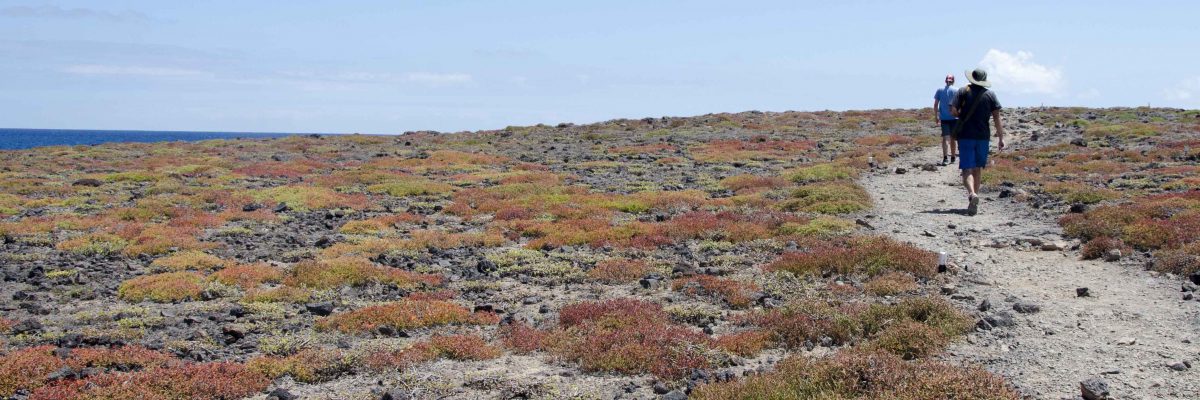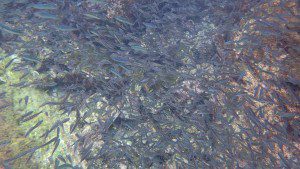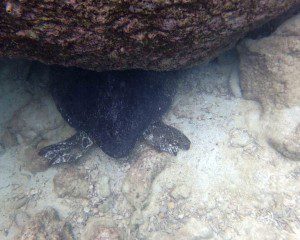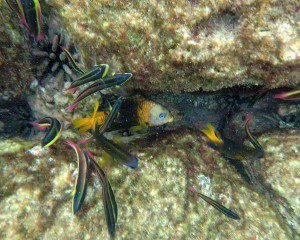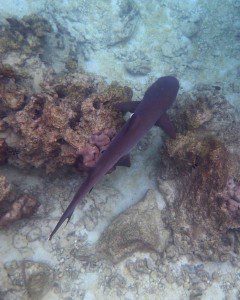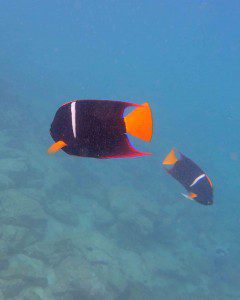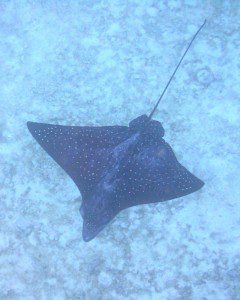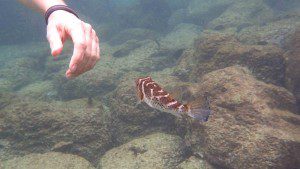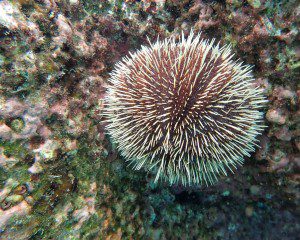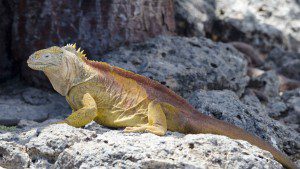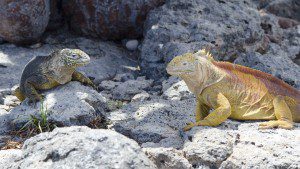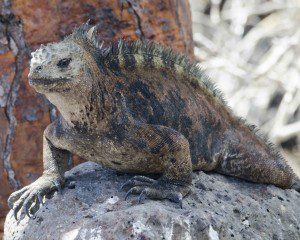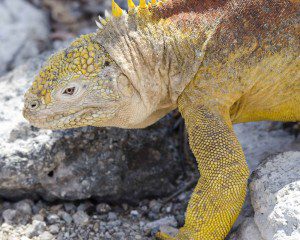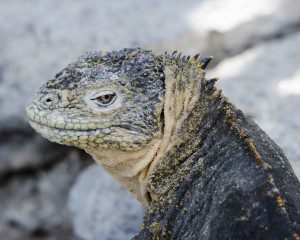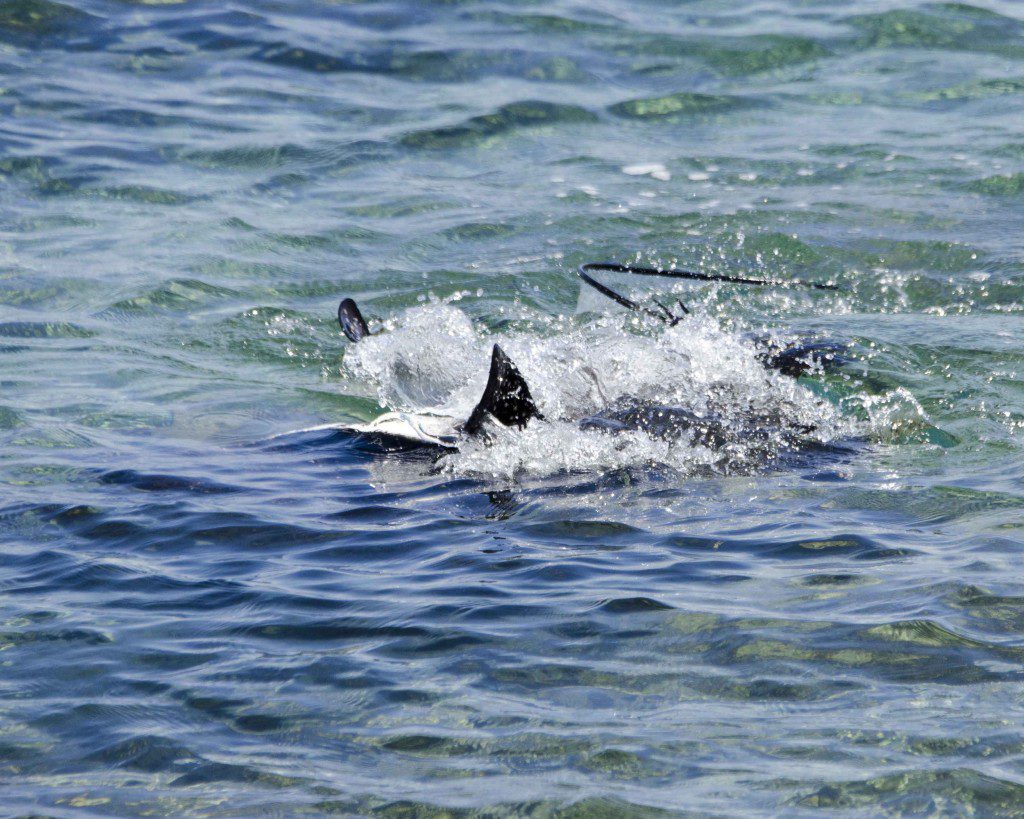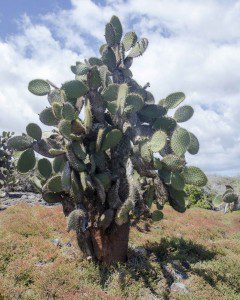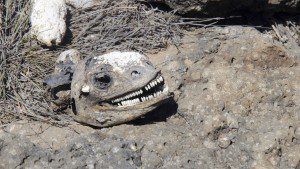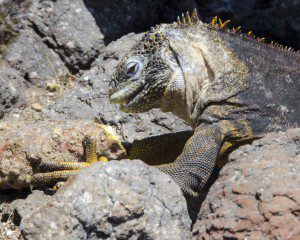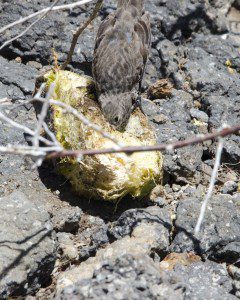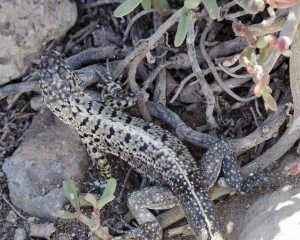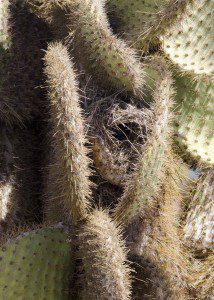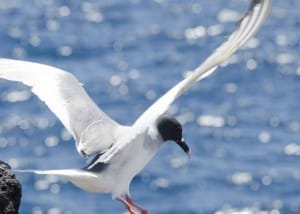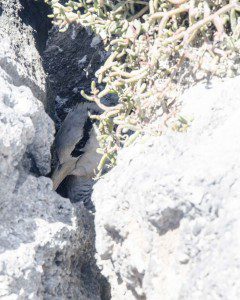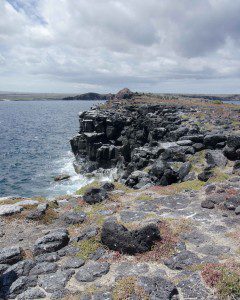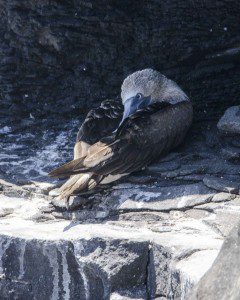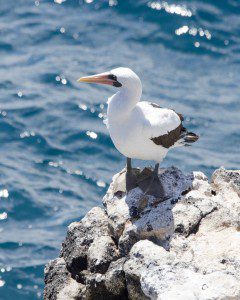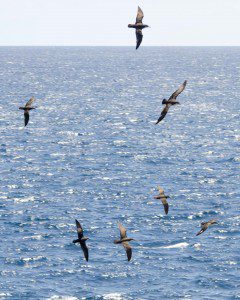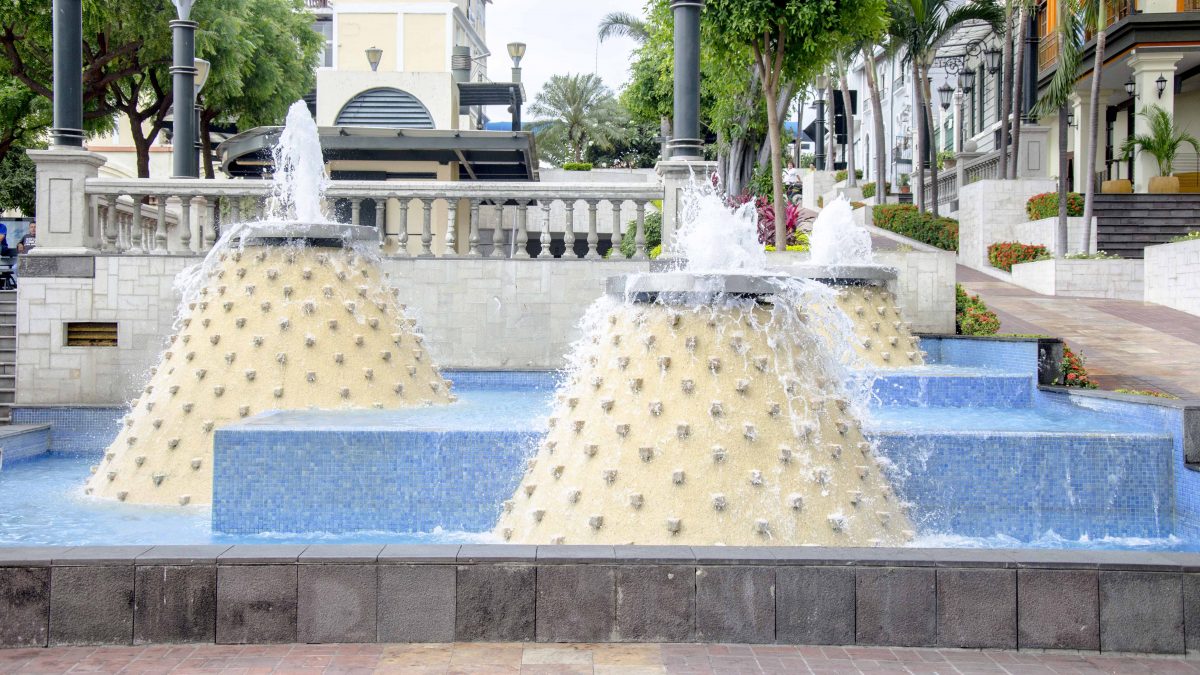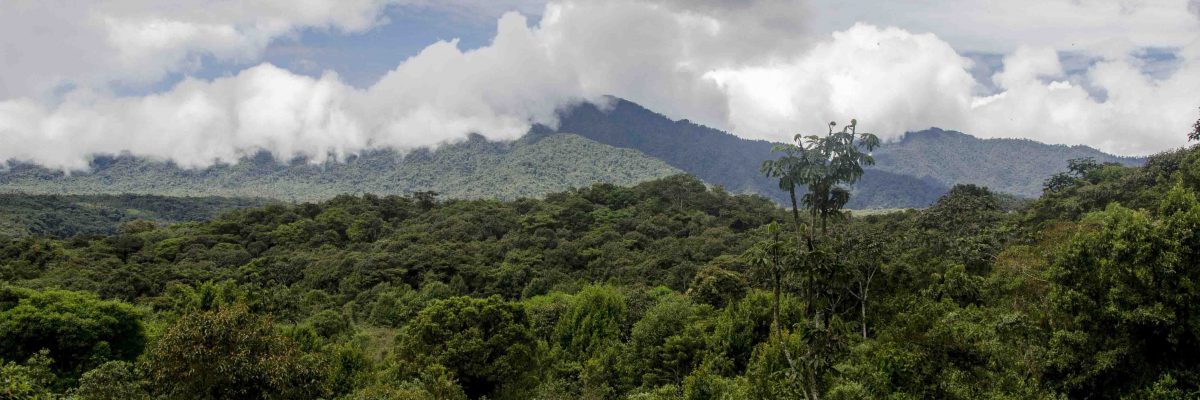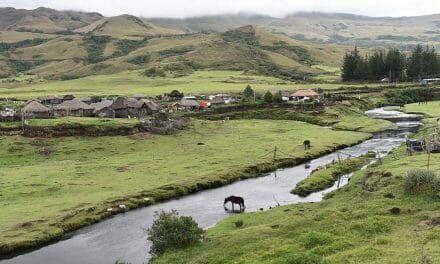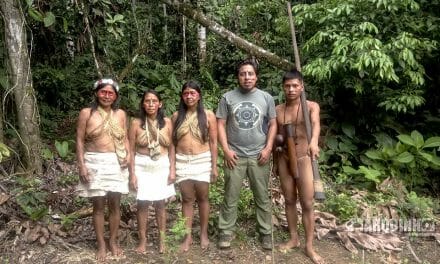As responsible travelers evolve, so do the stories we share.
This article is part of our living archive — trusted content we continue to care for.
First published on March 14, 2016 • Last updated on June 8, 2018.
On my very first visit to Santa Cruz Island, I fell in love with a golden iguana. Unfortunately, it was an iguana in captivity, held at the Charles Darwin Research Station. It felt wrong to be visiting the Galapagos and seeing animals kept in pens rather than in their native habitat.
So when returning to the Galapagos, I asked about seeing the Golden Iguana in the wild and was told I needed to visit South Plaza Island. This tiny island lies off the east coast of Isla Santa Cruz and is easily visited via day trip. We scheduled with Galapagos Alternatives and ended up on the Sea Finch, a yacht that generally holds sixteen tourists. But the day of our trip was undersold, likely due to fears of El Niño, and our family of four enjoyed the entire yacht to ourselves. It was an incredible experience.
Snorkeling Punta Carrión
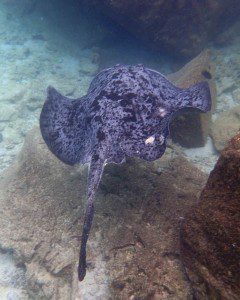 The day started with a drive across Santa Cruz Island from Puerto Ayora to the port at the Itabaca Canal. We boarded the Sea Finch and cruised northward through the canal until we reached Punta Carrión, a point where the Pacific Ocean meets the canal. Our adventure started there with a good hour of snorkeling. This location is an excellent place to see a wide variety of ocean life. It was recommended that we snorkel in a zig-zag pattern so that we could have greater opportunity to see large animals like sharks and rays in the deeper water along the sandy bottom of the canal and smaller fish, sea urchins, sea stars, and sea cucumbers in the nooks and crannies of the rocky shelf of the island. Excellent advice! We saw the largest ray of our lives – a 6-8 foot Marbled Ray. We’ve read that they can grow up to three meters in length. This specimen looked like a huge vacuum cleaner as he sucked up sand and debris from the ocean bottom. We also say Spotted Eagle Rays, White-tipped Sharks and Sea Tortoises cruising the depths. Along the rocks, there were thousands of fish, often in huge schools. My favorites were the black, red, and blue neon striped blennies, small, skinny fish. They swarmed and squirmed in and out of a narrow crack in the rocks likely looking for smaller prey. There were sea urchins galore, including the fat-spined Pencil Urchin on the open rocks and the more slender, long-spined purple-black Needle Sea Urchin in many of the crevices. If you like going tidepooling, you will love snorkeling this spot.
The day started with a drive across Santa Cruz Island from Puerto Ayora to the port at the Itabaca Canal. We boarded the Sea Finch and cruised northward through the canal until we reached Punta Carrión, a point where the Pacific Ocean meets the canal. Our adventure started there with a good hour of snorkeling. This location is an excellent place to see a wide variety of ocean life. It was recommended that we snorkel in a zig-zag pattern so that we could have greater opportunity to see large animals like sharks and rays in the deeper water along the sandy bottom of the canal and smaller fish, sea urchins, sea stars, and sea cucumbers in the nooks and crannies of the rocky shelf of the island. Excellent advice! We saw the largest ray of our lives – a 6-8 foot Marbled Ray. We’ve read that they can grow up to three meters in length. This specimen looked like a huge vacuum cleaner as he sucked up sand and debris from the ocean bottom. We also say Spotted Eagle Rays, White-tipped Sharks and Sea Tortoises cruising the depths. Along the rocks, there were thousands of fish, often in huge schools. My favorites were the black, red, and blue neon striped blennies, small, skinny fish. They swarmed and squirmed in and out of a narrow crack in the rocks likely looking for smaller prey. There were sea urchins galore, including the fat-spined Pencil Urchin on the open rocks and the more slender, long-spined purple-black Needle Sea Urchin in many of the crevices. If you like going tidepooling, you will love snorkeling this spot.
- A school of Black Striped Salema, Punta Carrion, Canal Itabaca, Isla Santa Cruz, the Galapagos.
- Sea Turtle; Punta Carrion, Canal Itabaca, Isla Santa Cruz, the Galapagos.
- Mexican Hogfish; Punta Carrion, Canal Itabaca, Isla Santa Cruz, the Galapagos.
- Sabertooth Blennies and an unidentified Rock Fish; Punta Carrion, Canal Itabaca, Isla Santa Cruz, the Galapagos.
- White Tipped Shark, Punta Carrion, Canal Itabaca, Isla Santa Cruz, the Galapagos
- King Angelfish; Punta Carrion, Canal Itabaca, Isla Santa Cruz, the Galapagos.
- Eagle Ray; Punta Carrion, Canal Itabaca, Isla Santa Cruz, the Galapagos.
- A Galapagos Puffer, Punta Carrion, Canal Itabaca, Isla Santa Cruz, the Galapagos.
- Sea Urchin; Punta Carrion, Canal Itabaca, Isla Santa Cruz, the Galapagos.
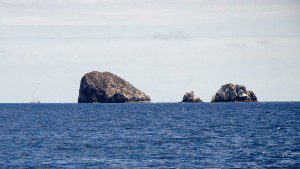 After snorkeling, we boarded the Sea Finch, toweled off, and made ourselves comfortable on the front deck. We cruised along the east coast of Isla Santa Cruz, occasionally seeing seabirds on the rocky ledges. We passed one of the more famous dive sights on the islands, Gordon Rocks. They stood stark and proud in the deep blue waters and it was only when we noticed boats alongside their rocky heights that we could tell how large they actually are.
After snorkeling, we boarded the Sea Finch, toweled off, and made ourselves comfortable on the front deck. We cruised along the east coast of Isla Santa Cruz, occasionally seeing seabirds on the rocky ledges. We passed one of the more famous dive sights on the islands, Gordon Rocks. They stood stark and proud in the deep blue waters and it was only when we noticed boats alongside their rocky heights that we could tell how large they actually are.
Hiking South Plaza
 Our arrival to South Plaza brought us alongside its sister island, North Plaza. In between the two, the water is a turquoise blue and hints at shallow, warmer waters where coral reefs hopefully thrive. The rocky shores of both islands make for great sea lion habitat and it’s worth keeping eyes open for any activity. The Sea Finch is too large to dock at South Plaza so we entered a small Zodiac for the short trip to the shore and had to fight for a spot with a few sea lions who had made the dock their sunbathing spot. And who could blame them? The day was beautiful and the flat, concrete surface soaked up the sun far better than the damp rocky shore.
Our arrival to South Plaza brought us alongside its sister island, North Plaza. In between the two, the water is a turquoise blue and hints at shallow, warmer waters where coral reefs hopefully thrive. The rocky shores of both islands make for great sea lion habitat and it’s worth keeping eyes open for any activity. The Sea Finch is too large to dock at South Plaza so we entered a small Zodiac for the short trip to the shore and had to fight for a spot with a few sea lions who had made the dock their sunbathing spot. And who could blame them? The day was beautiful and the flat, concrete surface soaked up the sun far better than the damp rocky shore.
Immediately upon hitting ground, we saw iguanas, both golden and marine. Our guide, Carlos, couldn’t get the information out fast enough. We learned about mating habits, conservation, diet, and more. One of the more interesting facts was that Golden Iguanas will sometimes mate with Marine Iguanas, even though they are different species. Their offspring are the equivalent of a mule (a cross between a male donkey and a female horse) and are unable to have offspring of their own. We saw only a single male Golden Iguana on the island but saw dozens of females, who are less stunningly golden but are very striking creatures, nonetheless.
- Golden Iguana, male, found on South Plaza Island, the Galapagos.
- Golden Iguanas, female and male, found on South Plaza Island, the Galapagos.
- Marine Iguana found on South Plaza Island, the Galapagos.
- Golden Iguana, male, found on South Plaza Island, the Galapagos.
- Golden Iguana, female, found on South Plaza Island, the Galapagos.
South Plaza has much more to offer than just iguanas. As we started hiking the trail around the island, we looked down into the shallow waters to see mating Spotted-Eagle Rays. The protected side of the island is habitat to many creatures and I could easily imagine spending an afternoon just gazing into the shallows. But the island called and the downside of any guided tour is that you must keep up with the guide.
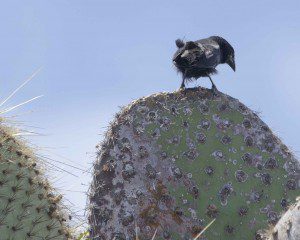 We hiked across rocky terrain covered with beautiful, tall Prickly-pear Cactus and low lying ground cover called Sesuvium that changed from green to orange to red depending on how much water it had received. The habitat is perfect not only for Golden Iguanas but for small lizards and the Cactus Finch.
We hiked across rocky terrain covered with beautiful, tall Prickly-pear Cactus and low lying ground cover called Sesuvium that changed from green to orange to red depending on how much water it had received. The habitat is perfect not only for Golden Iguanas but for small lizards and the Cactus Finch.
- Prickly Pear Cactus, South Plaza Island, the Galapagos.
- Iguana Skull, South Plaza Island, the Galapagos.
- Golden Iguana eating Prickly Pear Cactus fruit, South Plaza Island, the Galapagos.
- Cactus Finch eating Prickly Pear Cactus fruit, South Plaza Island, the Galapagos.
- Lava Lizard, South Plaza Island, the Galapagos.
- Cactus Finch nest, South Plaza Island, the Galapagos.
- South Plaza Island, the Galapagos.
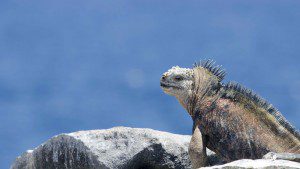 As we approached a high spot on the island and could look towards the less protected side, we could see that many more birds call this island home. The side of the island that faces Santa Cruz is a cliff with naturally occurring platforms that make perfect nesting sites for many ocean-going birds. We practically walked over a hidden nest of a Red-billed Tropicbird and once we realized how close we had come, we stepped back so that we could peer inside with a long lens. A female bird was quietly sitting and supposedly guarding her eggs.
As we approached a high spot on the island and could look towards the less protected side, we could see that many more birds call this island home. The side of the island that faces Santa Cruz is a cliff with naturally occurring platforms that make perfect nesting sites for many ocean-going birds. We practically walked over a hidden nest of a Red-billed Tropicbird and once we realized how close we had come, we stepped back so that we could peer inside with a long lens. A female bird was quietly sitting and supposedly guarding her eggs.
We watched Swallow-tail Gulls, Blue-footed Boobies, Nazca Boobies, and Brown Noddy Terns dance in flight, taking light from the cliff side and soaring over the open ocean. Because we were on top of the island, we had a bird’s eye view of many of the aerial acrobatics. Again, I could have spent hours just in this spot alone.
- Swallow-tailed Gull, South Plaza Island, the Galapagos
- Nesting Red-billed Tropicbird, South Plaza Island, the Galapagos
- Rocky Cliffs, South Plaza Island, the Galapagos
- Blue-footed Booby, South Plaza Island, the Galapagos
- Nazca Booby, South Plaza Island, the Galapagos
- Brown Noddy Terns, South Plaza Island, the Galapagos
But our hike was almost finished. We continued back to the small dock, snapping photos all along the way. And I began to wonder how difficult it would be to visit an island such as this and plan on spending an entire day, rather than just an hour or two. The Galapagos is in danger of being loved too much and I can understand why. The wild places like this one intentionally receive few visitors and those visitors are allowed on island for only a short time. The National Park strictly controls access and limits visits to only certain days. And I do hope they continue to do so with a firm hand and not give to pressure to allow more tourists access to the wildest places. The Galapagos and its creatures need protecting.

